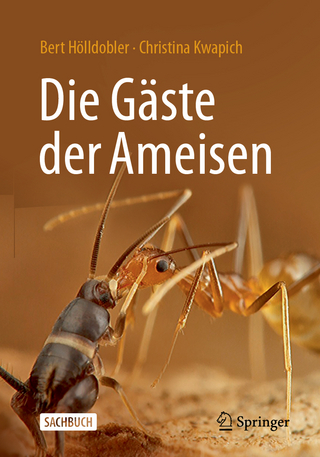
Bees as Superorganisms
Springer Berlin (Verlag)
978-3-662-59913-6 (ISBN)
- Titel wird leider nicht erscheinen
- Artikel merken
1 What Is a Superorganism?.- 1.1 From Cells to Metazoan Organisms.- 1.2 What Makes a Social Group a Superorganism?.- 1.3 Diversity of Superorganisms.- 1.3.1 Termites.- 1.3.2 Superorganismic Ants.- 1.3.3 Bees.- 1.3.4 The Naked Mole Rat.- 1.4 What Not to Expect from Superorganisms.- 2 Evolution of Superorganisms.- 2.1 From Solitary Individuals to Superorganisms: The Theories.- 2.1.1 Darwin's Dilemma.- 2.1.2 Individual Selection Models.- 2.1.2.1 Kin Selection.- 2.1.2.2 Assured Fitness Returns.- 2.1.2.3 Parental Manipulation.- 2.1.2.4 Mutualism and Reciprocal Altruism.- 2.1.2.5 Testing Theories.- 2.1.3 Group Selection.- 2.1.3.1 Classical Group Selection.- 2.1.3.2 Competitive Group Selection.- 2.1.3.3 Colony-Level Selection.- 2.1.3.4 Testing Theories of Group Selection.- 2.2 From Solitary Individuals to Superorganisms: The Evidence.- 2.2.1 Sociality in Bees.- 2.2.2 Solitary and Subsocial Bees.- 2.2.2.1 Megachile rotundata: The Individualist.- 2.2.2.2 Carpenter Bees: The Hierarchists.- 2.2.3 Primitively Social Bees.- 2.2.3.1 Exoneura bicolor Smith: The Mutualist.- 2.2.3.2 Halictine Bees: Getting Social.- 2.2.3.3 Bombus: Controlling Environment.- 2.2.4 Superorganismic Bees.- 2.2.4.1 Stingless Bees.- 2.2.4.2 Evolution Within the Genus Apis.- 3 Physiology.- 3.1 Development.- 3.1.1 From Egg to Adult.- 3.1.2 Caste.- 3.1.3 Birth, Aging, and Death of a Superorganism.- 3.1.3.1 Birth.- 3.1.3.2 Aging and Age Variation.- 3.1.3.3 Death and Immortality.- 3.2 Glands and Secretions.- 3.2.1 Endocrine System.- 3.2.2 Exocrine System.- 3.3 Feeding and Digestion.- 3.3.1 Nutrition.- 3.3.2 Food Exchange and the Meniscus Effect.- 3.3.3 Pollen Stores.- 3.3.4 Making Honey.- 3.4 Respiration.- 3.4.1 Respiration in Individuals.- 3.4.2 Respiration in Colonies.- 3.5 Circulation.- 3.5.1 Haemolymph Circulation.- 3.5.2 Circulation in the Colony.- 3.6 Colonial Excretion and Water Balance.- 3.7 Metabolic Physiology.- 3.7.1 Temperature Control.- 3.7.1.1 Cooling.- 3.7.1.2 Heating.- 3.7.1.3 Maintenance of Nest Temperature.- 3.7.1.4 Optimal Environmental Temperature and Nest Choice.- 3.7.2 Mass-Metabolism Relationships and Colony Fitness.- 3.7.3 Seasonal Relationships.- 3.8 Neurophysiology.- 3.8.1 Vision.- 3.8.2 Chemical Sense.- 3.8.3 Acoustic and Mechanical Reception.- 3.8.4 Special Sense, Learning and Integration.- 3.9 Muscle Function.- 3.9.1 Locomotion and Flight.- 3.9.2 Stinging and Biting.- 3.10 Circadian Rhythms and Sleep.- 3.10.1 Cyclic Metabolism.- 3.10.2 Cyclic Locomotion.- 3.10.3 Cyclic Ventilation.- 3.10.4 Sleep.- 4 Communication Network of the Superorganism.- 4.1 The Analysis of Communication Networks.- 4.2 Division of Labour.- 4.3 Food Procurement and Temperature Regulation.- 4.3.1 The Search for Food.- 4.3.1.1 Individual Search Pattern of a Scout.- 4.3.1.2 Foraging a Patch of Flowers.- 4.3.2 Communication Mechanisms.- 4.3.2.1 Round Dance.- 4.3.2.2 Waggle Dance.- 4.3.2.3 Acoustic Signals.- 4.3.2.4 Odour Signals.- 4.3.2.5 Dorsoventral Abdominal Vibration (DVAV) Dance.- 4.3.3 Central Food Handling and Social Integration.- 4.3.3.1 Amoeboid Foraging Pattern.- 4.3.3.2 Nectar Storage.- 4.3.3.3 Queueing.- 4.3.3.4 Comb Utilization.- 4.3.3.5 Water Handling.- 4.4 Search for Housing.- 4.4.1 Nest Site Selection.- 4.4.2 Swarm Orientation.- 4.4.3 Migration.- 4.5 Pheromones.- 4.5.1 Superorganismal Control.- 4.5.2 Queen Pheromones Inside the Nest.- 4.5.2.1 Queen Retinue Behaviour.- 4.5.2.2 Colony Stabilization and Ovary Suppression in Workers.- 4.5.3 Queen Pheromones Outside the Nest.- 4.5.3.1 Swarm Attraction.- 4.5.3.2 Sex Attractant.- 4.5.4 Worker Pheromones.- 4.5.4.1 Orientation.- 4.5.4.2 Colony Defence.- 4.5.5 Other Pheromones and Odours.- 4.6 Learning.- 4.7 Social Intelligence and Network Analysis.- 4.7.1 Social Intelligence.- 4.7.2 Network Analysis.- 5 Ecology.- 5.1 Demography of Natural Populations.- 5.1.1 Life History Strategies.- 5.1.1.1 Sessile Phase.- 5.1.1.2 Mobile Phase.- 5.1.1.3 Life Cycle.- 5.1.2 Spatial and Temporal Distribution.- 5.1.2.1 Colony Defence.- 5.
| Erscheinungsdatum | 24.07.2019 |
|---|---|
| Zusatzinfo | XVI, 395 p. |
| Verlagsort | Berlin |
| Sprache | englisch |
| Maße | 155 x 235 mm |
| Themenwelt | Naturwissenschaften ► Biologie ► Humanbiologie |
| Naturwissenschaften ► Biologie ► Ökologie / Naturschutz | |
| Naturwissenschaften ► Biologie ► Zoologie | |
| Schlagworte | Biology • Development • Ecology • Evolution • Insects • Migration • Muscle • Neurophysiology • Nutrition • Parasites • Physiology • Reproduction • Social behavior • Sociobiology • System |
| ISBN-10 | 3-662-59913-9 / 3662599139 |
| ISBN-13 | 978-3-662-59913-6 / 9783662599136 |
| Zustand | Neuware |
| Haben Sie eine Frage zum Produkt? |
aus dem Bereich


